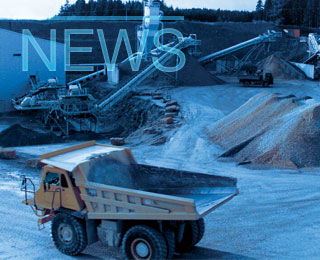A control system/integrated drive system solution from Siemens at Hanson Cement’s Ketton plant in the UK has produced a number of significant benefits for the cement giant and has improved the operation’s sustainability, reports Siemens.
The clinker cooler upgrade project at Ketton carried out by Siemens has resulted in an annual CO2 reduction of 771t and over GBP86,000 saved in energy use, much of it through the use of variable speed drive technology and Siemens‘ integrated drive systems technology (IDS).
Siemens solution
The Siemens solution included the implementation of each of the drive chains, which formed the control system (CS) IDS total engineered solution. The total solution included six G150 Sinamics converters, ranging from 45kW to 160kW, and pressure differential instruments for PI loop control, interfacing into the current DCS system via Profibus. These particular converters used enhanced energy-saving functions. Insulated bearings were also fitted to the existing motors at the plant. Full power and control cable upgrades were also included, complete with full site installation and commissioning of the complete clinker cooler process. Siemens provided full engineering and project management of the turnkey solution and full technical documentation.
Trevor Jibb is Hanson’s electrical engineer (designate) at Ketton. He was delighted with the benefits of the clinker cooler upgrade: “The significant energy savings we’ve already made, coupled with the reduction in carbon footprint mean that Ketton continues to be a great example of best practice within our Group.“
An additional benefit to Ketton of the upgrade has been a reduction in noise levels and vibration at the clinker cooler plant, improving conditions for the workforce as well as for the surrounding environment.
Hanson Cement, which is part of the global HeidelbergCement Group, was the first UK cement producer to carry out annual environmental audits of its sites and the Ketton site, near Stamford, is a flagship in working with local conservation groups to protect the bio-diversity of the flora and fauna in and around its quarry.
Ketton has been a cement works since 1928 and is today one of the most efficient in Europe. By continuing to invest in modern plant and equipment the site aims for the increased use of alternative fuels to replace the traditional use of coal. Currently, around 60 per cent of fuel used comes from alternative sources such as meat and bone meal, solid recovered fuel from local authority waste and liquid chemical waste. Ketton also has a 12 megawatt solar energy farm, covering 20 hectares of restored quarry workings and generating around 13 per cent of the plant’s annual electricity consumption.
Siemens originally estimated the ROI at Ketton to be within 17 months and the energy savings to be £73,000, with the CO2 reduction at 651 tonnes per year, so the actual savings of £86,000, 771 tonnes in CO2 reduction and 14 months payback period were even better news for Hanson.
Siemens application engineer Gary Palmer was responsible for the upgrade project at Ketton: “The efficiency improvements we were able to bring Hanson at Ketton meant that the investment paid for itself in just over a year and is continuing to help Hanson make ongoing energy and CO2 savings well into the future. The additional environmental benefits have yet to be measured, but are also considerable, as they should include lower maintenance requirements of the mechanical and electrical infrastructure through reduced vibration.“

Argentina's cement market expands 18% in April
Cement consumption in Argentina grew 17.7 per cent YoY to 837,328t in April 2025 from 655,650t i...